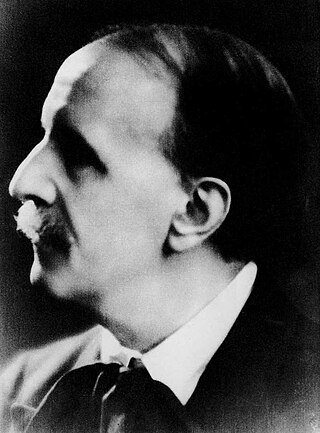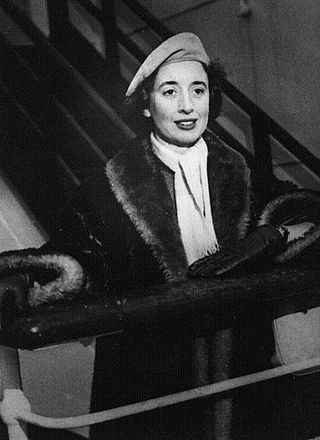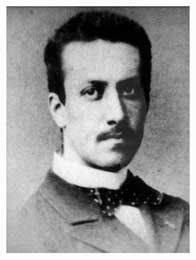The Symphony for Organ No. 5 in F minor, Op. 42, No. 1, was composed by Charles-Marie Widor in 1879, with numerous revisions published by the composer in later years. The full symphony lasts for about 35 minutes.
The Symphony for Organ No. 5 in F minor, Op. 42, No. 1, was composed by Charles-Marie Widor in 1879, with numerous revisions published by the composer in later years. The full symphony lasts for about 35 minutes.
The piece consists of five movements:
The fifth movement, in F major, is often referred to as just Widor's Toccata because it is his most famous piece. It lasts around six minutes. Its fame in part comes from its frequent use as recessional music at festive Christmas and wedding ceremonies. [1]
The melody of Widor's Toccata is based upon an arrangement of rapid staccato arpeggios which form phrases, initially in F, moving in fifths through to C major, G major, etc. Each phrase consists of one bar. The melody is complemented by syncopated chords, forming an accented rhythm against the perpetual arpeggio motif. The phrases are contextualised by a descending bass line, often beginning with the 7th tone of each phrase key. For example, where the phrase consists of an arpeggio in C major, the bass line begins with a B♭. The arpeggios eventually modulate through all twelve keys, until Widor brings the symphony to a close with fff block chords in the final three bars.
Many organists play it at a very fast tempo whereas Widor preferred a more controlled articulation to be involved. He recorded the piece, at St. Sulpice in his eighty-ninth year; the tempo used for the Toccata is quite slow.
Following Widor's example, other composers adopted this style of toccata as a popular genre in French Romantic organ music, including notable examples from Eugène Gigout, Léon Boëllmann, Louis Vierne, Henri Mulet, and Marcel Dupré.

Charles-Marie-Jean-Albert Widor was a French organist, composer and teacher of the late Romantic era. As a composer he is known for his ten organ symphonies, especially the toccata of his fifth organ symphony, which is frequently played as recessional music at weddings and other celebrations.

Louis Victor Jules Vierne was a French organist and composer. As the organist of Notre-Dame de Paris from 1900 until his death, he focused on organ music, including six organ symphonies and a Messe solennelle for choir and two organs. He toured Europe and the United States as a concert organist. His students included Nadia Boulanger and Maurice Duruflé.

Toccata is a virtuoso piece of music typically for a keyboard or plucked string instrument featuring fast-moving, lightly fingered or otherwise virtuosic passages or sections, with or without imitative or fugal interludes, generally emphasizing the dexterity of the performer's fingers. Less frequently, the name is applied to works for multiple instruments.
The Piano Quintet in F minor, Op. 34, by Johannes Brahms was completed during the summer of 1864 and published in 1865. It was dedicated to Her Royal Highness Princess Anna of Hesse. As with most piano quintets composed after Robert Schumann's Piano Quintet (1842), it is written for piano and string quartet.
The organ repertoire is considered to be the largest and oldest repertory of all musical instruments. Because of the organ's prominence in worship in Western Europe from the Middle Ages on, a significant portion of organ repertoire is sacred in nature. The organ's suitability for improvisation by a single performer is well adapted to this liturgical role and has allowed many blind organists to achieve fame; it also accounts for the relatively late emergence of written compositions for the instrument in the Renaissance. Although instruments are still disallowed in most Eastern churches, organs have found their way into a few synagogues as well as secular venues where organ recitals take place.

Jeanne Marie-Madeleine Demessieux was a French organist, pianist, composer, and teacher. She was the chief organist at Saint-Esprit for 29 years and at La Madeleine in Paris starting in 1962. She performed internationally as a concert organist and was the first female organist to sign a record contract. She went on to record many organ works, including her own compositions.
Kevin John Bowyer is an English organist, known for his prolific recording and recital career and his performances of modern and extremely difficult compositions.
Joan Lippincott is an American concert organist and former head of the organ department at Westminster Choir College in Princeton, New Jersey.
Michael Murray is an American-born organist and writer.
Christopher Noel Rawsthorne was a British liturgical and concert organist and composer of music for his own instrument, as well as choral music.
Iain Farrington is a British pianist, organist, composer and arranger. He performs regularly with some of the country's leading singers, instrumentalists and choirs, as well as giving solo recitals.
Tolga Kashif is a British born musical conductor, composer, orchestrator, producer and arranger of Turkish Cypriot descent.
Robert Quinney is Director of the Choir of New College, Oxford, and was formerly Sub-Organist at Westminster Abbey and Director of Music at Peterborough Cathedral. In addition to his work at New College, he has a freelance career as soloist, ensemble player, and writer on music. From October 2009 till 2014 he was Director of Oundle for Organists, whose residential courses provide inspiring tuition for young organists.
Michael Stockwin Howard was an English choral conductor, organist and composer. He was an important part of the Early Music movement in the middle of the last century, in particular as a celebrated interpreter of 16th century polyphony In his later years he made notable recordings of the late French Romantic school of organ composers, particularly César Franck, on the Cavaillé Coll organ at St. Michael's Abbey in Farnborough. The National Pipe Organ Register now claims that the organ appears in a list of organs by Mutin.

The Twelve Grand Concertos, Op. 6, HWV 319–330, by George Frideric Handel are concerti grossi for a concertino trio of two violins and cello and a ripieno four-part string orchestra with harpsichord continuo. First published by subscription in London by John Walsh in 1739, they became in a second edition two years later Handel's Opus 6. Taking the older concerto da chiesa and concerto da camera of Arcangelo Corelli as models, rather than the later three-movement Venetian concerto of Antonio Vivaldi favoured by Johann Sebastian Bach, they were written to be played during performances of Handel's oratorios and odes. Despite the conventional model, Handel incorporated in the movements the full range of his compositional styles, including trio sonatas, operatic arias, French overtures, Italian sinfonias, airs, fugues, themes and variations and a variety of dances. The concertos were largely composed of new material: they are amongst the finest examples in the genre of baroque concerto grosso.
The Musette, or rather chaconne, in this Concerto, was always in favour with the composer himself, as well as the public; for I well remember that HANDEL frequently introduced it between the parts of his Oratorios, both before and after publication. Indeed no instrumental composition that I have ever heard during the long favour of this, seemed to me more grateful and pleasing, particularly, in subject.

Johann Vexo is a French organist. He is the organist for both the choir organ at Notre Dame de Paris and the great organ of Nancy Cathedral.

The Symphony for Organ No. 6 in G minor, Op. 42, No. 2, is an organ symphony by Charles-Marie Widor. Completed in 1878, the composer premiered it at the Palais du Trocadéro as part of the Paris World Exhibition. It was first published by Hamelle in 1879, together with the famous Symphony for Organ No. 5.

The Organ Symphony No. 3 in F-sharp minor, Op. 28, is an organ symphony by Louis Vierne. He composed it in 1911, and it was first performed in March 1912. It was first published by Éditions Durand the same year. It has been described as the most inspired and best structured of his six organ symphonies.

Gereon Krahforst is a German composer, concert organist, pianist, harpsichordist, and church musician.

Surrexit a mortuis, Op. 23, No. 3, is a composition for choir and two organs by Charles-Marie Widor. The text is an anonymous Latin Easter hymn. Named a motet, it was first published by Hamelle in 1906. The single work was published by Dr. J. Butz in 2008.